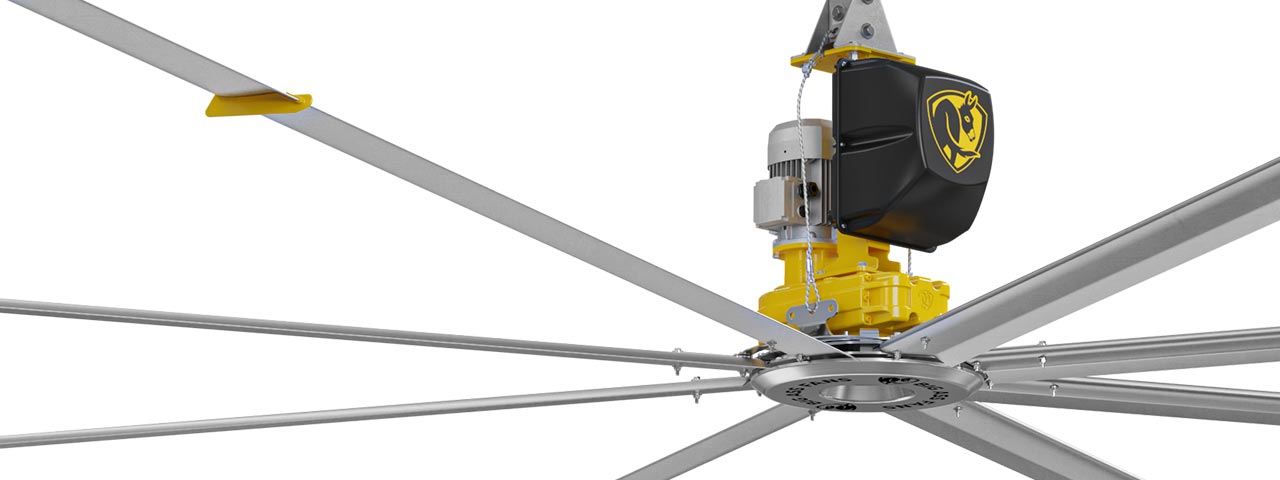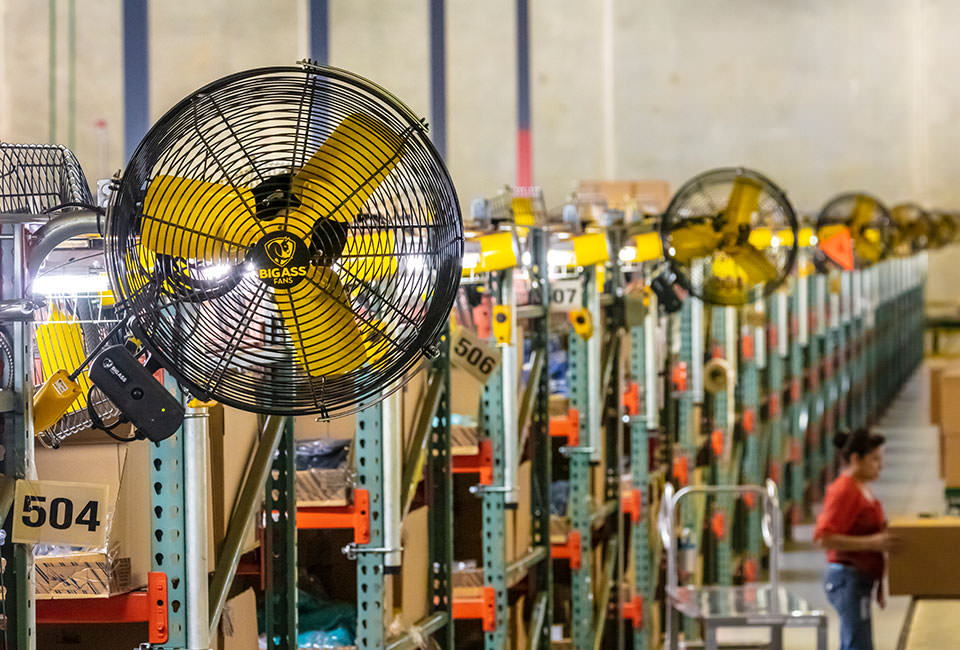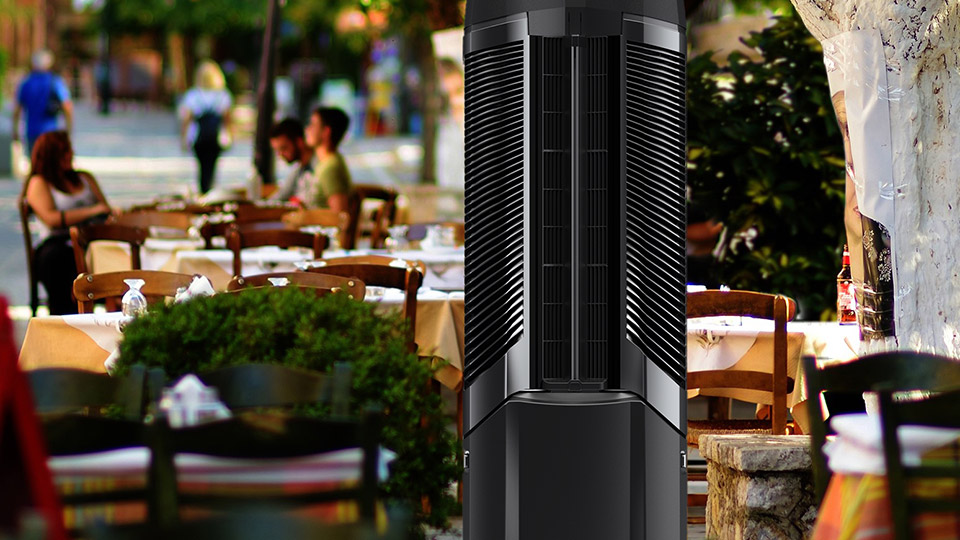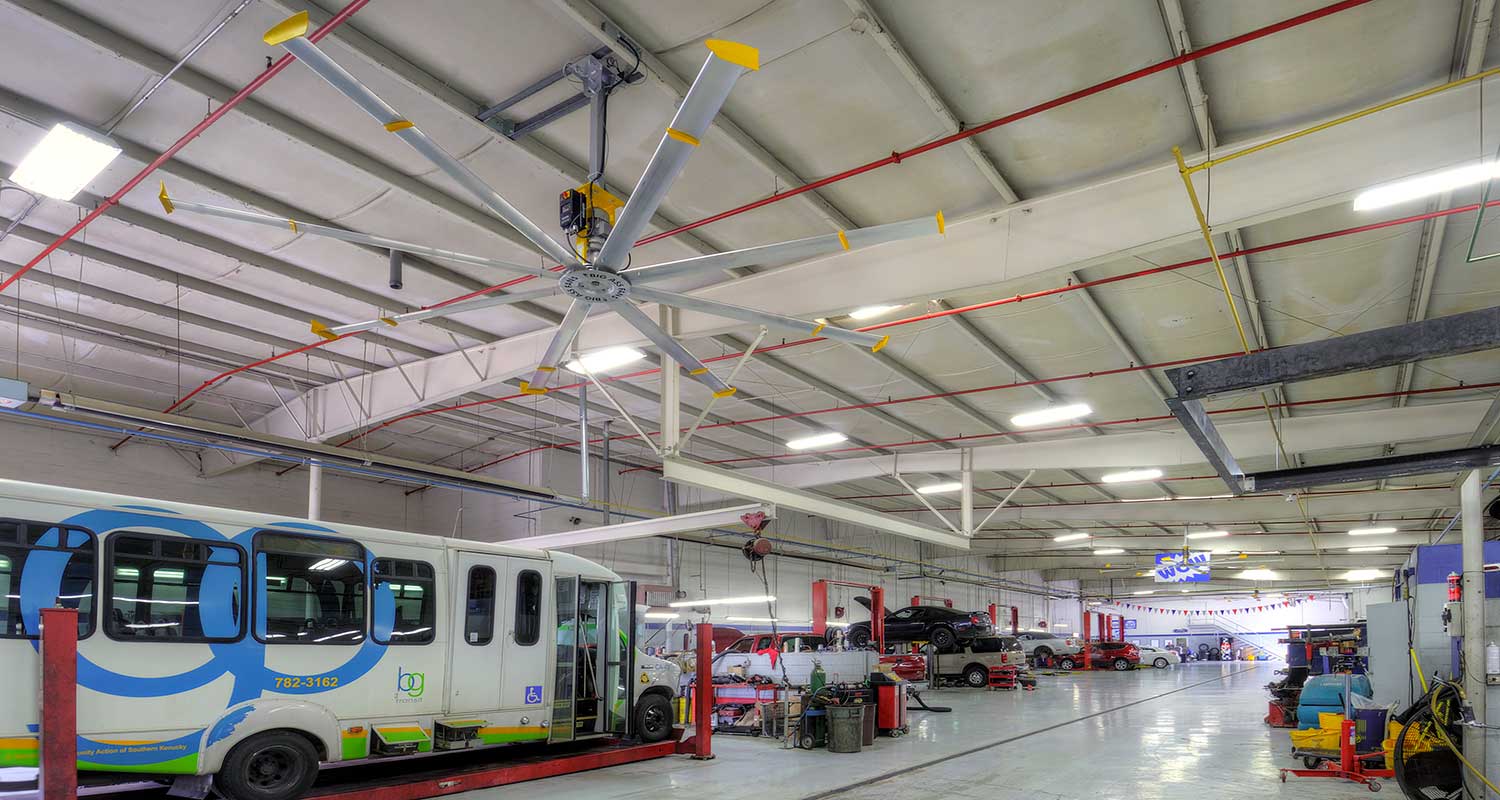FREQUENTLY ASKED QUESTIONS
Here are a few of the questions we hear the most around here. If you don't see what you're looking for, reach out to us anytime.ABOUT BIG ASS FANS
HOW DO I CHECK MY ORDER STATUS?
Click here to check on your order. You’ll need your order number and the email used when the order was placed, whether online or over the phone.
Our Customer Service team is in the office ready to help during the following hours (all times are in EST).
Monday – Friday 7:30 AM – 7:00 PM EST
Saturday 10 AM – 6 PM EST
At any time, you can email questions to support@bigassfans.com.
WHO IS BIG ASS FANS?
Big Ass Fans designs and manufactures large-diameter ceiling fans for industrial and commercial use. It is headquartered in Lexington, Kentucky, where all aspects of the business are centered, from R&D to assembly to marketing to sales.
Carey Smith founded the HVLS Fan Co. in 1999. The company’s original name described its flagship product — high volume, low speed fans — literally. The fans used their massive size, not speed, to cool large spaces that lacked air conditioning, such as factories and dairy barns, and the company quickly expanded. Several years after its launch, in response to customers who called asking about “those big-ass fans,” Smith officially changed its name.
When churches wanted to install fans to keep congregations comfortable, Big Ass Fans developed the first silent fan motor. Other kinds of public and private spaces followed. In 2008, the company opened its first overseas office in Australia. In 2009 in Lexington, it cut the ribbon on the world’s only R&D lab dedicated to testing large fans, a LEED® Gold facility.
Big Ass Fans launched its Haiku residential line in 2012, and it has taken off in the years since. The year 2014 was notable for the hiring of the company’s 500th employee, the debut of Big Ass Light’s industrial-strength LED fixtures, and the introduction of Haiku with SenseMe™ technology, the world’s first smart ceiling fan.
Big Ass Fans continues to expand and innovate, adding employees and overseas offices and exploring new areas in search of problems to solve.
WHY DO I NEED A BIG ASS FAN?
Big Ass Fans make sense for any individual or organization looking to increase comfort, save on energy bills and feel good about reducing their carbon footprint. Big Ass Fans are ideal for any space where air conditioning is not an option — including the Great Outdoors. However, they also complement HVAC systems by silently circulating forced air, hot and cold; the result is improved productivity and overall well-being. And Big Ass Fans are built to last in Lexington, Kentucky, and backed by exceptional warranties and customer service.
Looking for bullet points? Big Ass Fans offer the following:
- Energy efficiency — but don’t take our word for it. Check out our awards from the U.S. Green Building Council and our ENERGY STAR® ratings.
- Comfort — Big Ass Fans create a cooling effect of up to 10°F (6°C), and when the furnace is running, they gently push heated air down from the ceiling without an unpleasant draft, so that a uniform temperature prevails throughout.
- Energy savings — Not only do Big Ass Fans use minimal energy themselves, but they also can significantly lower air conditioning bills in summer, and depending on ceiling height, can reduce heating bills by up to 30 percent in winter.
- Superb engineering — We have the awards and hundreds of patents to prove it. At our lab, we test, retest, and then test some more.
- Expert service — We’ll make sure you get the right fan for your space and budget, expert installation and incomparable service throughout the life of your fan, which we guarantee will be a very, very long time.
- Good looks — We have fans to complement any space, from airplane hangars to zen retreats.
- Silence — It’s golden, and hard to come by, especially in ceiling fans. We provide it.
- Workplace reputation — We’re a privately owned business company that’s regularly voted one of the best places to work. Our employees are paid well, with good benefits, and perks. Forbes recently included us on its list of Best Small Companies in America.
- Company name — We have a name that’s a conversation starter. But if it’s a conversation you’d rather not have, we are happy to remove it from your fan before installation.
- Opportunity to feel good about yourself — A direct result of purchasing a product that offers all of the above.
WHERE CAN I BUY A BIG ASS FAN?
Big Ass Fans are currently in more than 125 countries and can be delivered nearly anywhere in the world that comfort, energy efficiency and good looks are valued.
Call us at 1-855-660-0498 or complete a form to speak to a Big Ass Fans expert about how to buy.
Select Big Ass products are also sold on our online store, at specialty retailers and through retail home-improvement outlets online.
WHERE ARE BIG ASS FANS MADE?
Nearly all Big Ass Fans are manufactured at its production facilities in Lexington, Kentucky, where it is headquartered. That includes all its industrial and commercial fans as well as its smaller Haiku fans.
Big Ass Fans takes tremendous pride in being a major employer in its hometown. Its reliance on local manufacturing derives not just from its commitment to the community but also its focus on quality control and customer satisfaction. Most of the company’s main suppliers are within a day’s drive, making it easy to get to know the factories where components are made and the people who work in them. Furthermore, because most Big Ass Fans customers are in North America, the company knows that keeping its manufacturing at home allows it to respond to customers’ needs in the fastest and most efficient way possible.
HOW DO I INSTALL A BIG ASS FAN?
Every fan manufactured by Big Ass Fans, from a 24-foot Powerfoil X3.0 to a 52-inch Haiku, has different specifications. To ensure that you’re following the correct steps for installing your particular fan, please go to that fan’s product page on our website. There you’ll find a link to the product installation guide that’s specifically written for your fan. Or you can visit our support page.
General Questions
WHICH DIRECTION SHOULD CEILING FANS GO IN WINTER?
For decades, people have been told to set their ceiling fans to reverse, or clockwise, in winter to push down the heat that collects at the ceiling. But like many long-held beliefs, this is not exactly true.
As many people have found, traditional flat-bladed fans must be turned on at high speed when in reverse to effectively push warm air down to occupant level. That inevitably creates an uncomfortable draft and uses more energy.
WHAT IS THERMAL COMFORT?
Thermal comfort is most easily explained as a feeling of personal satisfaction with the thermal environment, in other words, feeling neither cold nor hot.
Thermal comfort, also called human comfort, is an individual, subjective assessment and therefore can be difficult to measure. However, it plays an essential role in the design and maintenance of any facility with live occupants. For builders’ purposes, thermal comfort is defined by international comfort standards, the most important of which are ANSI/ASHRAE Standard 55, ISO 7730 and EN-15251.
ASHRAE Standard 55 establishes the ranges of indoor environmental conditions that are acceptable to achieve thermal comfort. This standard has been regularly updated since first published in 1966, with the latest revision in 2013. It estimates that for thermal comfort purposes, temperature could range from between approximately 67°F and 82°F, though thermal comfort is determined by a combination of six factors:
- Metabolic rate: The energy generated by the body — in other words, activity level
- Clothing insulation: The level of insulation provided by the clothing an individual is wearing
- Air temperature: The temperature of the air surrounding the occupant
- Radiant temperature: The weighted average of all the temperatures from surfaces surrounding an occupant
- Air speed: Rate of air movement given distance over time
- Humidity: Moisture content in the air
In addition to HVAC systems, ceiling fans are known to play a big role in thermal comfort. Big Ass Fans® improve thermal comfort by providing steady air circulation. Though air movement does not lower room temperature, it creates a cooling effect of up to 10°F (6°C) when the breeze passes over the skin. And when the furnace is on, the fans slowly push the warm air that collects at the ceiling down without creating a draft, resulting in a more even temperature throughout a space.
WHAT IS THE DIFFERENCE BETWEEN INDUSTRIAL AND COMMERCIAL FANS?
Ceiling fans are categorized as industrial or commercial based on the environment in which they are used. Industrial ceiling fans are designed to increase comfort in challenging and frequently noisy industrial settings such as warehouses, distribution centers and factories. Commercial ceiling fans, for the most part, work in conjunction with heating and cooling systems in spaces where silent operation and aesthetics are valued, such as schools, churches, retail outlets and offices.
At Big Ass Fans, we design and rigorously test all our fans — industrial, commercial and residential — with three objectives in mind: performance, reliability and durability. Throughout the process, the fan’s intended environment guides our design decisions. Big Ass Fans has earned hundreds of patents because of this focus on industry-leading research and development.
WHAT IS EVAPORATIVE COOLING?
As water (or any substance) evaporates, the liquid left behind becomes cooler. What we think of as temperature is really the average kinetic energy of the molecules of a substance. Molecules with higher kinetic energy move faster and are more likely to leave the liquid as a gas. When they do, they take this energy with them and leave behind molecules with lower kinetic energy, and therefore lower temperature. This process is known as evaporative cooling.
In many living organisms, including humans, evaporative cooling plays a vital role in maintaining body temperature. By releasing sweat, which is 90 percent water, humans can utilize the effects of evaporative cooling to give off heat to the surrounding air, even if that air is warmer than their body temperature.
When humans cool themselves, they give off heat and moisture to the surrounding air, causing it to become hotter and more humid, and reducing its capacity to absorb additional heat and moisture. This layer of hot humid air forms a blanket around the body, reducing its ability to give off excess heat.
WHAT IS DESTRATIFICATION?
Destratification is a term that describes the process of reducing thermal stratification.
When heat is introduced into a space, it forms temperature layers, or strata. The warmest air is at the ceiling; the coolest is at the floor, where people work and live. That’s because heated air from a forced air system is 5% to 10% lighter than air at desirable room temperatures (roughly 65 to 75°F, or 18 to 24°C). Heated air naturally rises to the highest point in a space, where temperatures can reach roughly 85 to 125°F (29 to 52°C) depending on a structure’s features and ceiling height.
The thermostat, typically at floor level, registers the temperature of the cooler, denser air, meaning the furnace is forced to over-deliver in an effort to reach the desired thermostat setting.
WHAT ARE HVLS FANS?
Technically, an HVLS — high-volume, low-speed — fan is a ceiling fan greater than 7 feet (2.1 meters) in diameter. Unlike a small, high-velocity fan that creates small, turbulent air streams that quickly disperse, an HVLS fan relies on size, not speed, to move a significant amount of air. Originally designed for large spaces such as barns and factories, HVLS fans have evolved as technology has rapidly improved. They now are found in a wide variety of industrial, commercial and residential spaces, often working in conjunction with HVAC systems for energy savings. In fact, energy-efficient HVLS fans have quickly assumed a leading role in the green building movement.
The air from an HVLS fan moves toward the floor in a column that radiates in all directions, flowing horizontally until it reaches a wall — or airflow from another fan — at which point it turns upward and flows back toward the fan. This creates convection-like air currents that build as the fan continues to spin. The increased air circulation effectively removes hot, humid air and replaces it with drier air. The result is a silent, non-disruptive and even distribution of 3- to 5-mph breezes over large spaces, with a perceived cooling effect on occupants of up to approximately 10°F (6°C). During winter, HVLS fans effectively redistribute warm air trapped at the ceiling down to floor level.
Because of their size, HVLS fans are effective and efficient. Using ¾- to 2-hp motors, they consume power at a fraction of the cost of multiple small ceiling fans. Big Ass Fans® couple energy-efficient motors with variable frequency drives and patented airfoil designs inspired by airplane wings to move large volumes of air quietly and efficiently. With HVLS fans from 8 to 24 feet in diameter, Big Ass Fans offers sizes to suit all applications.
HOW FAST SHOULD I RUN MY CEILING FAN?
IN THE SUMMER
In the summer, the purpose of a ceiling fan is to enhance cooling by creating a breeze across your skin – this speeds evaporation of moisture on your skin, and it’s that evaporation of moisture that actually creates the cooling effect.
If you have high ceilings, when the fan is first turned on you may feel an increase in temperature as warm air is brought down from under the ceiling. This effect will soon dissipate, and then the cooling effect will begin.
Beyond this, adjust the fan for your comfort: faster if you feel warm, slower if you feel cool (or if papers are flying around the room).
Fans do not cool the air in a room. Therefore, there is no benefit in leaving a fan running when there are no people in the room; this just wastes electricity. The cooling effect of a fan takes place only when the moving air encounters a person’s skin.
Haiku’s “Smarter Cooling” setting takes care of this automatically. Big Ass Fans equipped with SmartSense technology also take the guesswork out of the process.
IN THE WINTER
In the winter, you don’t want to feel the cooling effect of a breeze across your skin. Therefore, the fan should run very slowly.
If you have high ceilings, operate the ceiling fan at its lowest possible speed to bring the warm air trapped at the ceiling down to occupant level.
If your fan can run slowly enough to not create a breeze at its lowest speed setting, it is most efficient and most effective to operate the fan in its “forward” position (blowing downward). This is true of all Big Ass Fans across our industrial, commercial and residential lines.
If you continue to feel a breeze at the lowest setting, you can still benefit by operating the fan only when there are no people in the room to feel the draft.
Haiku’s “Smarter Heating” setting takes care of this automatically, as does SmartSense technology on Big Ass industrial fans.
HOW DO CEILING FANS COOL A ROOM?
Unlike air-conditioning, a ceiling fan doesn’t actually make the air in a room or space cooler. Instead, the fan cools the occupants in it. The breeze from a properly sized and placed ceiling fan cools occupants by disrupting the stagnant layer of air that surrounds the body, preventing heat loss. The removal of that insulating layer of air increases a body’s heat loss to make it feel cooler.
Heat loss (cooling) can come in two forms: cool air passing over the skin removes heat via convection and relatively dry air passing over the skin increases the rate of perspiration evaporation. Learn more about evaporative cooling. Because a ceiling fan cools occupants but not spaces, it makes sense to turn off a fan in an empty room, unless air circulation is required for reasons other than comfort.
Big Ass Fans® create cooling breezes that make a person feel up to 10°F (6°C) cooler while requiring minimal power to operate. They do this by relying on size rather than speed. While spinning at a low speed the 52-in to 24-ft diameter fans move large amounts of air, efficiently providing that cooling breeze.
HOW BIG SHOULD A CEILING FAN BE?
There are some basic rules of thumb for determining the right size ceiling fan for a given space, although lots of variables must also be considered. Rarely is a space wide open, without dividers, racking, furniture or other obstructions. However, the following guidelines are a good place to start:
For most industrial and commercial large-diameter ceiling fans:
- The square footage of the space in which a fan is going should be 5-7 times the diameter of the fan. In other words, a 14-ft fan (measured from tip to tip at its widest point) would cover an area of at least 4,900 square feet. (That’s 5×14=70; 70×70=4,900.) The largest industrial ceiling fan made is 24 feet tip to tip; it would cover approximately 14,400 square feet. (24tx5=120×120=14,400.)
- The fan tips must be 2 feet away from any ceiling obstructions or features, such as lights, trusses, beams or disco balls.
- There should be enough distance between the ceiling and the fan that the fan doesn’t “suffocate” and has adequate space above it. This is generally 5-7 feet from the ceiling, depending on the fan’s diameter.
- The fan should spin from 10 to 24 feet from the ground — often this recommendation is stated as the fan should spin its diameter above the floor.
HOW BIG ARE HVLS FANS?
An HVLS fan (high-volume, low-speed) is a ceiling fan with a tip to tip diameter greater than 7 feet (2.1 meters). The HVLS fan’s size and design allow it to move large amounts of air at a slow speed. The result is energy efficiency and comfort.
A high-quality HVLS fan gently circulates air to create a cooling effect of up to 10°F (6°C). It also works with a forced hot air system to push warm air down from the ceiling in winter, resulting in savings of up to 30 percent.
LOOKING FOR CUSTOMER SUPPORT?
Head to our Support section and get some answers.

















